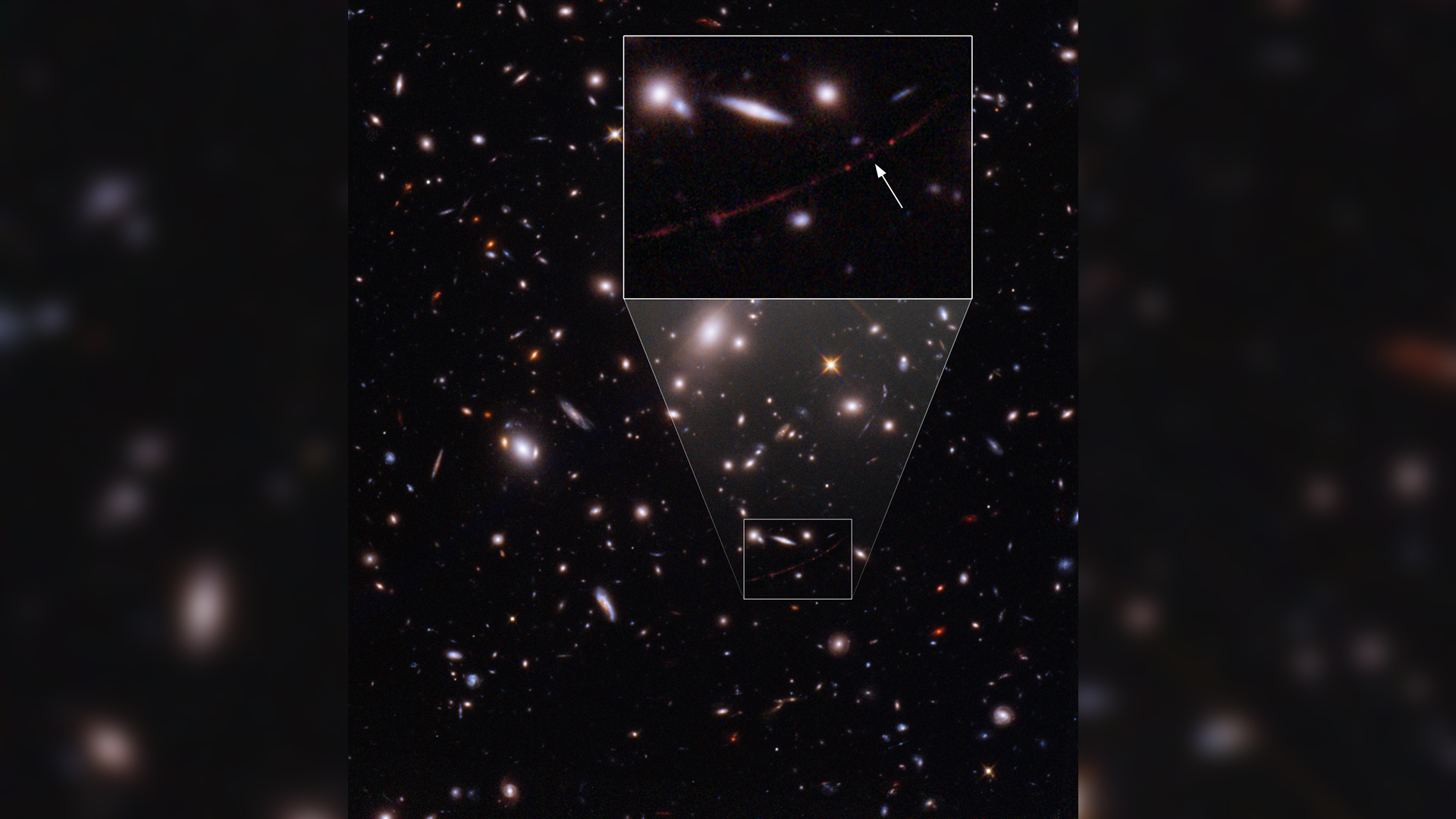Hubble Space Telescope spots most distant single star ever seen
Meet Earendel, a star whose light took 12.9 billion years to reach Earth.

The most distant single star seen yet dates back to less than 1 billion years after the universe's birth in the Big Bang, and may shed light on the earliest stars in the cosmos, a new study finds.
The scientists nicknamed the star "Earendel," from an Old English word meaning "morning star" or "rising light." Earendel, whose technical designation is WHL0137-LS, is at least 50 times the mass of the sun and millions of times as bright.
This newfound star, detected by NASA's Hubble Space Telescope, is so far away that its light has taken 12.9 billion years to reach Earth, appearing to us as it was when the universe was about 900 million years old, just 7% of its current age. Until now, the most distant single star detected, discovered by Hubble in 2018, existed when the universe was about 4 billion years old, or 30% of its current age.
"This finding gives us an opportunity to study a star in detail in the early universe," study lead author Brian Welch, an astrophysicist at Johns Hopkins University in Baltimore, told Space.com.
Related: The best Hubble Space Telescope images of all time!
Normally, even a star as brilliant as Earendel would be impossible to see from Earth given the vast divide between the two. Previously, the smallest objects seen at such a great distance were clusters of stars embedded inside early galaxies.
Scientists detected Earendel with the help of a huge galaxy cluster, WHL0137-08, sitting between Earth and the newfound star. The gravitational pull of this enormous galaxy cluster warped the fabric of space and time, resulting in a powerful natural magnifying glass that greatly amplified the light from distant objects behind the galaxy, such as Earendel. This gravitational lensing has distorted the light from the galaxy hosting Earendel into a long crescent the researchers named the Sunrise Arc.
Breaking space news, the latest updates on rocket launches, skywatching events and more!
The rare way in which Earendel aligned with WHL0137-08 meant that the star appeared directly on, or extremely close to, a curve in spacetime that provided maximum brightening, causing Earendel to stand out from the general glow of its home galaxy. This effect is analogous to the rippled surface of a swimming pool creating patterns of bright light on the bottom of the pool on a sunny day — the ripples on the surface act as lenses and focus sunlight to maximum brightness on the pool floor.
Welch emphasized this is not the most distant object scientists have ever discovered. "Hubble has observed galaxies at greater distances," he explained. "However, we see the light from their millions of stars all blended together. This is the most distant object where we can identify light from an individual star."
He also noted this star was distant, but not old. "We see the star as it was 12.8 billion years ago, but that does not mean the star is 12.8 billion years old," Welch said. Instead, it's probably just a few million years old and never reached old age.
"Given its mass, it almost certainly has not survived to today, as more massive stars tend to burn through their fuel faster and thus explode, or collapse into black holes, sooner," he added of Earendel. "The oldest stars known would have formed at a similar time, but they are much less massive, so they have continued to shine until today."
Many details about Earendel remain uncertain, such as its mass, brightness, temperature and type. Scientists are not even sure yet if Earendel is one star or two — most stars of Earendel's mass usually do have a smaller, dimmer companion, and it's possible that Earendel is outshining its partner.
Scientists intend to conduct followup observations with NASA's recently launched James Webb Space Telescope to analyze Earendel's infrared light and pin down many of its features. Such information in turn could help shed light on the first stars in the universe, which formed before the universe was filled with the heavy elements produced by successive generations of massive stars.
"I think one of the most exciting things about this result is that it opens a new window into the early universe," Welch said. "Typically at these distances, we see full galaxies as small, fuzzy objects, and we then infer details about the stars within from their aggregate light."
Not so for Earendel. "With this lensed star, we can study its light independently," he said. "This lets us compare directly to stars in the Milky Way and look for differences which will improve our understanding of stars in the early universe."
The scientists detailed their findings online Wednesday (March 30) in the journal Nature.
Follow us on Twitter @Spacedotcom and on Facebook.

Charles Q. Choi is a contributing writer for Space.com and Live Science. He covers all things human origins and astronomy as well as physics, animals and general science topics. Charles has a Master of Arts degree from the University of Missouri-Columbia, School of Journalism and a Bachelor of Arts degree from the University of South Florida. Charles has visited every continent on Earth, drinking rancid yak butter tea in Lhasa, snorkeling with sea lions in the Galapagos and even climbing an iceberg in Antarctica. Visit him at http://www.sciwriter.us


